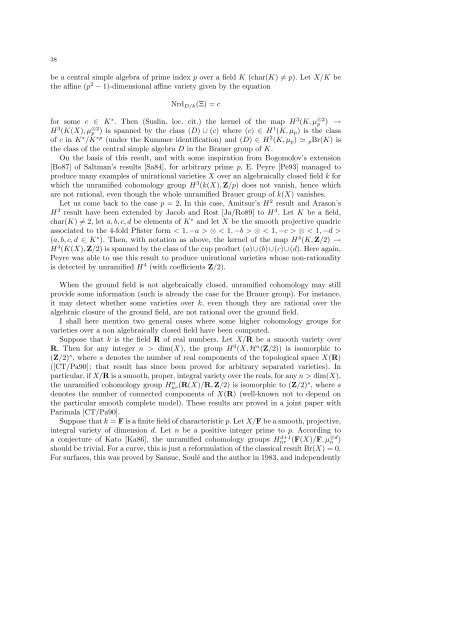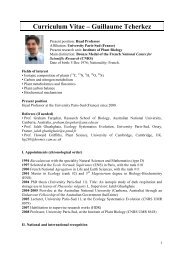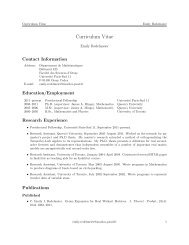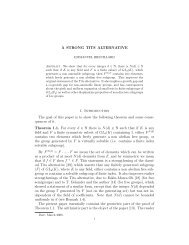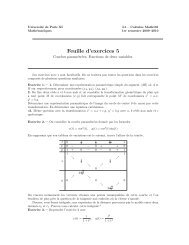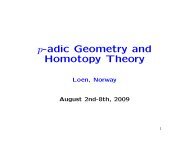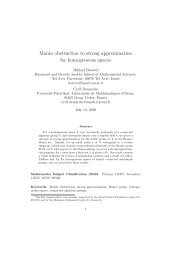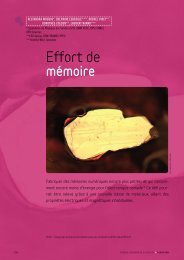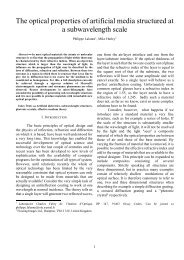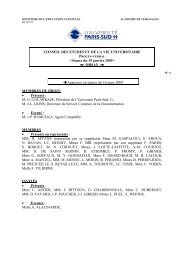Birational invariants, purity and the Gersten conjecture Lectures at ...
Birational invariants, purity and the Gersten conjecture Lectures at ...
Birational invariants, purity and the Gersten conjecture Lectures at ...
You also want an ePaper? Increase the reach of your titles
YUMPU automatically turns print PDFs into web optimized ePapers that Google loves.
38<br />
be a central simple algebra of prime index p over a field K (char(K) ≠ p). Let X/K be<br />
<strong>the</strong> affine (p 2 − 1)-dimensional affine variety given by <strong>the</strong> equ<strong>at</strong>ion<br />
Nrd D/k (Ξ) = c<br />
for some c ∈ K ∗ . Then (Suslin, loc. cit.) <strong>the</strong> kernel of <strong>the</strong> map H 3 (K, µ ⊗2<br />
p ) →<br />
H 3 (K(X), µ ⊗2<br />
p ) is spanned by <strong>the</strong> class (D) ∪ (c) where (c) ∈ H 1 (K, µ p ) is <strong>the</strong> class<br />
of c in K ∗ /K ∗p (under <strong>the</strong> Kummer identific<strong>at</strong>ion) <strong>and</strong> (D) ∈ H 2 (K, µ p ) ≃ p Br(K) is<br />
<strong>the</strong> class of <strong>the</strong> central simple algebra D in <strong>the</strong> Brauer group of K.<br />
On <strong>the</strong> basis of this result, <strong>and</strong> with some inspir<strong>at</strong>ion from Bogomolov’s extension<br />
[Bo87] of Saltman’s results [Sa84], for arbitrary prime p, E. Peyre [Pe93] managed to<br />
produce many examples of unir<strong>at</strong>ional varieties X over an algebraically closed field k for<br />
which <strong>the</strong> unramified cohomology group H 3 (k(X), Z/p) does not vanish, hence which<br />
are not r<strong>at</strong>ional, even though <strong>the</strong> whole unramified Brauer group of k(X) vanishes.<br />
Let us come back to <strong>the</strong> case p = 2. In this case, Amitsur’s H 2 result <strong>and</strong> Arason’s<br />
H 3 result have been extended by Jacob <strong>and</strong> Rost [Ja/Ro89] to H 4 . Let K be a field,<br />
char(K) ≠ 2, let a, b, c, d be elements of K ∗ <strong>and</strong> let X be <strong>the</strong> smooth projective quadric<br />
associ<strong>at</strong>ed to <strong>the</strong> 4-fold Pfister form < 1, −a > ⊗ < 1, −b > ⊗ < 1, −c > ⊗ < 1, −d ><br />
(a, b, c, d ∈ K ∗ ). Then, with not<strong>at</strong>ion as above, <strong>the</strong> kernel of <strong>the</strong> map H 4 (K, Z/2) →<br />
H 4 (K(X), Z/2) is spanned by <strong>the</strong> class of <strong>the</strong> cup product (a)∪(b)∪(c)∪(d). Here again,<br />
Peyre was able to use this result to produce unir<strong>at</strong>ional varieties whose non-r<strong>at</strong>ionality<br />
is detected by unramified H 4 (with coefficients Z/2).<br />
When <strong>the</strong> ground field is not algebraically closed, unramified cohomology may still<br />
provide some inform<strong>at</strong>ion (such is already <strong>the</strong> case for <strong>the</strong> Brauer group). For instance,<br />
it may detect whe<strong>the</strong>r some varieties over k, even though <strong>the</strong>y are r<strong>at</strong>ional over <strong>the</strong><br />
algebraic closure of <strong>the</strong> ground field, are not r<strong>at</strong>ional over <strong>the</strong> ground field.<br />
I shall here mention two general cases where some higher cohomology groups for<br />
varieties over a non algebraically closed field have been computed.<br />
Suppose th<strong>at</strong> k is <strong>the</strong> field R of real numbers. Let X/R be a smooth variety over<br />
R. Then for any integer n > dim(X), <strong>the</strong> group H 0 (X, H n (Z/2)) is isomorphic to<br />
(Z/2) s , where s denotes <strong>the</strong> number of real components of <strong>the</strong> topological space X(R)<br />
([CT/Pa90] ; th<strong>at</strong> result has since been proved for arbitrary separ<strong>at</strong>ed varieties). In<br />
particular, if X/R is a smooth, proper, integral variety over <strong>the</strong> reals, for any n > dim(X),<br />
<strong>the</strong> unramified cohomology group Hnr(R(X)/R, n Z/2) is isomorphic to (Z/2) s , where s<br />
denotes <strong>the</strong> number of connected components of X(R) (well-known not to depend on<br />
<strong>the</strong> particular smooth complete model). These results are proved in a joint paper with<br />
Parimala [CT/Pa90].<br />
Suppose th<strong>at</strong> k = F is a finite field of characteristic p. Let X/F be a smooth, projective,<br />
integral variety of dimension d. Let n be a positive integer prime to p. According to<br />
a <strong>conjecture</strong> of K<strong>at</strong>o [Ka86], <strong>the</strong> unramified cohomology groups Hnr<br />
d+1 (F(X)/F, µ ⊗d<br />
n )<br />
should be trivial. For a curve, this is just a reformul<strong>at</strong>ion of <strong>the</strong> classical result Br(X) = 0.<br />
For surfaces, this was proved by Sansuc, Soulé <strong>and</strong> <strong>the</strong> author in 1983, <strong>and</strong> independently


